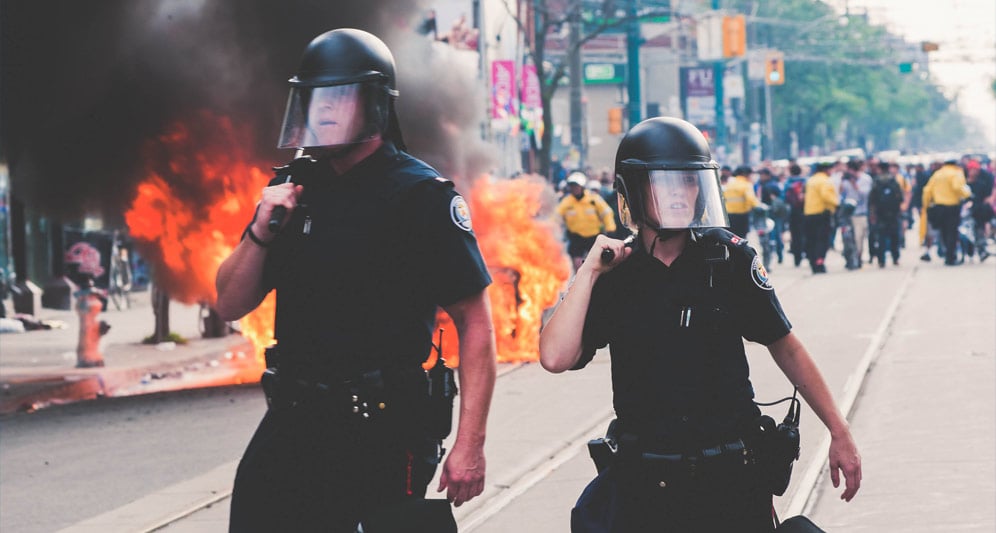It keeps your officers safe
Officers put their lives on the line every day. Even seemingly mundane situations can quickly escalate, putting officers in danger.
Your law enforcement agency must arm your officers with the proper information and training to keep them safe.
Law enforcement use-of-force policy can give officers tactics to defuse a situation before it gets out of hand. Good policy provides guidelines for effectively dealing with armed or aggressive individuals.
Paired with training, use-of-force policy helps officers come home safe at the end of the day.
It builds community trust and keeps civilians safe
.jpg?width=996&name=powerdms-assets-photos-063-women-cop-arrest-girl%20(1).jpg)
Trust is an essential component of effective community policing. Civilians must know that they can trust police officers to protect them.
Transparency about how and when officers will use force can help build this trust. It's crucial to let your community know that officers will treat them with respect.
It reduces liability risks
According to the Institute for Criminal Justice Education, use-of-force is consistently one of the highest liability areas for law enforcement agencies.
In recent years, use-of-force incidents have become even more tricky because of the increased scrutiny officers face.
Between security cameras, body-worn cameras, and civilian cell phone cameras, officers face the potential of their every move being captured on film.
This means that even minor incidents can be blown out of proportion and lead to negative attention for your department. Split-second decisions made in the heat of the moment can now be scrutinized by citizens watching the news in their living rooms—or by judges sitting in the relative comfort of their chambers.
If your department doesn’t have solid use-of-force policy in place, these incidents can have significant repercussions for your officers.
Effective use-of-force policy helps your officers make better decisions in the moment. It also protects them in the aftermath of an incident.
If your agency can show that the officer received proper training and adhered to policy, you reduce your risks for liability.
Use-of-force case law
Your department must take case law into account when crafting any policy. Overall, laws make it the duty of the law enforcement agency to train officers on the appropriate use of force.
Monell v. Department of Social Services
In the Monell decision, the Supreme Court held that government entities can be sued if their policies or official procedures result in a violation of civil rights. This applies whether the violation is intentional or unintentional.
This means that outdated or incomplete use-of-force policy can put your entire agency at risk. To avoid Monell violations, your agency must create and maintain a comprehensive use-of-force policy.
You should regularly update your policy and consult lawyers and civil rights organizations to make your policy thorough, constitutional, and balanced.
But even the best policy won’t help if your officers don’t follow it. You must distribute updates to your use-of-force policy, regularly train officers, and put accountability measures in place.
Other important cases
Graham v. Connor provides some protection to your officers if they do wind up in court.
The Supreme Court decision states that courts should judge use-of-force cases on whether the actions of the officer on the scene were “objectively reasonable” in light of what that officer knew and perceived.
Good law enforcement use-of-force policy helps officers discern what is reasonable in different situations.
Law enforcement use-of-force policy should take special care with incidents of deadly force.
In Tennessee v. Garner, the Supreme Court ruled that:
“The Fourth Amendment prohibits the use of deadly force unless it is necessary to prevent the escape of a fleeing felon and the officer has probable cause to believe that the suspect poses a significant threat of violence to the officer or the community.”
Your agency's use-of-force policy must adhere to this standard.
Considerations for law enforcement use-of-force policy
Law enforcement use-of-force policy should account for the case law described above. It should also comply with any other federal, state, and local laws surrounding use-of-force.
And, beyond laws, your use-of-force policy should meet the standards of professional police practices.
Current case law and industry standards dictate that police officers should use only the amount of force necessary to bring an incident under control, make an arrest, or protect themselves or others.

Make sure your policy emphasizes this rule. Use-of-force should be an officer’s last resort in any situation.
Police departments across the country are also shifting policy and training to emphasize de-escalation tactics. Your agency may want to consider following suit.
When writing or revising your use-of-force policy, it’s wise to consult other agencies, officers, legal counsel, and subject-matter experts.
Here are a few general rules to keep in mind for creating effective law enforcement use-of-force policy.
Your policy should be comprehensive

Just like any policy, your use-of-force policy should be guided by your agency’s underlying mission and values.
The policy won’t be able to cover every possible situation officers will face, but emphasizing guiding principles and values will help them make responsible decisions.
Your department’s use-of-force policy should be as thorough as possible. The policy should lay out when and how officers are authorized to use force and the types of situations that justify each level of force.
It should also cover the different types of weapons officers are authorized to use, and when they should use them.
Your policy should be clear and specific
Law enforcement use-of-force policy shouldn’t be too broad or vague. To avoid confusion, your policy should define key terms.
For example, the IACP’s National Consensus Policy on Use of Force defines phrases such as “objectively reasonable,” “choke hold,” and “deadly force.”
While officers ultimately have to decide how much force to use in a situation, your policy should establish guidelines and restrictions for using each level of force.
Your policy should be consistent
Law enforcement agencies often update policy through internal memorandums and directives. This can leave officers referring to outdated use-of-force policies or conflicting standards.
It’s crucial to make sure that your use-of-force policy is consistent all the way through and lines up with other department policies.
Using a policy management tool such as PowerDMS can help you track revisions and make sure all your officers only access the most updated policy.
Resources for creating your agency’s use-of-force policy:
- IACP’s National Consensus Policy on Use of Force
- PERF’s Guiding Principles on Use of Force
- Seattle’s Use of Force Policy
A law enforcement use-of-force policy is just one of the 12 crucial law enforcement policies every agency needs to protect its community, minimize liability risks, and protect its reputation.
